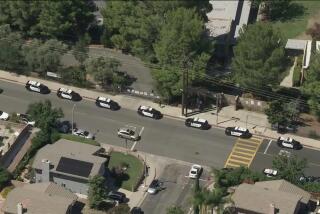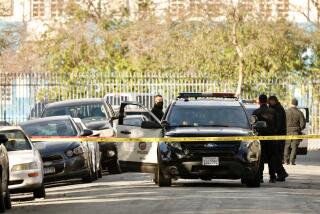Children’s Legacy of Violence
- Share via
No one who crossed paths with Roosevelt High School senior Rodrigo Banuelos Jr. completely escaped the effects of his fatal shooting May 24.
Banuelos’ four younger siblings still alternate from rage to fear to grief. A 5-year-old nephew dreams of revenge. Four classmates were so upset by the sight of his empty desk that they cut homeroom class for the rest of the semester. Fifty students asked to speak to a counselor.
For the record:
12:00 a.m. Sept. 30, 1999 For the Record
Los Angeles Times Thursday September 30, 1999 Home Edition Part A Page 3 Metro Desk 1 inches; 32 words Type of Material: Correction
School violence--With a story in Tuesday’s Times on children exposed to school violence, the captions on two photographs of psychology experiments at UCLA should have identified Nathan Soussi as a volunteer control subject.
A 10-year-old neighbor said that for security, he now sleeps with a battered rifle stock that he found in a trash can. A 14-year-old neighbor said he strikes up aimless chatter with teachers just to be near an adult. Both boys’ grades have dropped dramatically since the slaying.
What some see as another achingly familiar homicide in the heart of the largest concentration of street gangs in California underlines what neurobiologists have come to believe is a fundamental truth: Even indirect exposure to violence can interfere with a child’s development and academic performance.
Student counselors say that Banuelos was the fourth Roosevelt High student killed since January. Although no formal count exists, counselors believe as many as 20 Roosevelt High students have been killed in recent years. Many more have been injured, physically and psychologically, by violence at home and in the streets.
To be sure, crime is going down in Los Angeles and urban centers nationwide. And the Los Angeles Unified School District has been trumpeting the fact that no one was killed on any of its 660 campuses last year.
But it is also true that violence hits some neighborhoods--and the children who live in them--harder than others.
Robert Pynoos, director of UCLA’s Trauma Psychiatry Program and one of the world’s leading experts on post-traumatic stress in children, believes that Roosevelt and all schools need more mental health services as much as they need more armed guards, surveillance cameras and metal detectors.
“Safety is important, but we’re shortchanging our children by dealing only with violence prevention,” Pynoos said. “Children exposed to violence and disaster deserve at least the same ongoing psychological treatment we provide firemen and police officers.”
A backlog of children need help, he said. At one San Fernando Valley high school alone, 42 students said they had been shot off-campus at some point in their lives, he said. “They felt alienated and had lost all ambition for higher education, even the capacity to maintain peer relationships. Yet not one had received treatment for post-traumatic stress.”
Pynoos and other researchers are shifting their attention from the symptoms of children’s exposure to catastrophe--sleep disorders, aggression, flashbacks, hyperactivity, problems with memory and attention--to the physiology and brain chemistry underlying such behavioral changes.
Psychological Aftermath
Research has already documented exaggerated startle reactions in children who are exposed to extreme violence, a sign that extreme vigilance to ensure personal security is skewing their personalities.
Researchers also know that the intense negative emotions unleashed by exposure to violence can harm a child’s attention span and overall maturing mechanisms, placing him or her at greater risk of academic failure.
Children exposed to violence suffer greater rates of depression, anxiety, post-traumatic stress disorder and alcohol and drug abuse, and have significantly lower academic achievement, researchers say.
Of the 22.3 million children in the United States between the ages of 12 and 17, 1.8 million have been the victims of serious sexual assault, 3.9 million have been the victims of serious physical assault, and 9 million have witnessed serious violence, according to the U.S. Department of Justice.
“People tend to think kids are resilient, but science shows more and more that’s not necessarily so,” said Alan Steinberg, a research scientist at UCLA’s neuropsychiatric institute. “It’s not normal to be constantly on the lookout for danger, to have recurring nightmares, to be jumpy and aggressive all the time.”
But many questions remain. Exactly what impact does exposure to violence have on a child’s neurotransmitters, hormones and regulation of the autonomic nervous system? Could chronic exposure produce the same kinds of brain stem abnormalities reported among some combat veterans? If so, what are the implications for a child’s ability to learn and retain new information?
“Right now, we’re doing new research on adolescents exposed to violence and the implications for their immune systems,” said Pynoos, whose test subjects include children from across Los Angeles and around the world.
Los Angeles Unified School District Police Chief Wesley Mitchell tries to stay abreast of such groundbreaking research into the children he calls “collateral victims”--the usually silent students who have witnessed horrific events but show no obvious signs of harm.
“We’ve reduced the presence of violence, guns and knives on campus--but not the fear,” Mitchell said.
Although identifying and treating children caught in abusive homes or neighborhoods is not easy, Baltimore; Nashville; Charlotte, N.C.; Buffalo, N.Y.; Boston; New Orleans; and New Haven, Conn., all have created law enforcement-mental health partnerships to provide immediate support to children suffering from violence or emotional trauma.
In Los Angeles, a partnership of city and county law enforcement, mental health and social service agencies was launched in January to evaluate and expand programs that treat youths exposed to violence. Similar pilot projects are being operated in the communities of Lennox and Pasadena under UCLA’s neuropsychiatric institute.
May Be Thousands Who Need Help
Los Angeles Mayor Richard Riordan’s year-old volunteer Crisis Response Team, which is dispatched to the most gruesome homicides, suicides and car crashes in the city, alerts schools about children who might need counseling.
But the local efforts desperately need more funding, said county Supervisor Zev Yaroslavsky. “It’s an investment in resources and time that can pay huge dividends for the victims and society,” he said. “All an adult has to do to recognize the extent of the problem is talk to ‘most any kid in a public school; they can recite volumes about what the real world is like here.”
Karen Wagener, executive director of the mayor’s volunteer effort, put it another way: “There may be thousands of kids in Los Angeles who’ve witnessed horror and don’t get the counseling they need and deserve.”
The communities served by Los Angeles Unified’s Roosevelt school cluster east of downtown are a case in point. There were 7,208 calls for police assistance in the region during the last year.
In just a few hours, random interviews with Roosevelt High School students turned up nearly a dozen students who had witnessed extremely frightening events and were left feeling afraid, helpless and misunderstood.
One 15-year-old girl, regarded as chronically truant by school officials, said she ditched school for two months after seeing a friend shot in the back of the head during a drive-by shooting.
“I was afraid to go to school, afraid that someone would ask me what happened,” she said. “But I didn’t want to remember. Instead of going to school, I watched television every day at a friend’s house.”
A 14-year-old ninth-grader who had been sent to the dean’s office for fighting with a classmate, recalled standing frozen with fear four days earlier as “an older man was beaten down by gangs right in front of me.”
“I couldn’t sleep that night because I kept seeing the man’s bloody face in my mind,” he said. “I just kept wondering if that guy was all right.”
When he returned to class, he could not concentrate on his classwork because he remembered the man’s suffering and the blood on his face.
“I remembered how he didn’t want to go to the hospital when the ambulance came,” he said. “I remembered how he stared at me. I remembered feeling scared.”
After witnessing that beating, the youth was reprimanded for throwing gum and erasers at a fellow student and yelling at his teacher.
Police Chief Mitchell was not surprised by the aggression.
“There’s a reason why a kid goes from Cs to Fs in a matter of weeks, why a kid who’s been independent starts clinging to adults, why docile kids suddenly want to fight with anybody they meet,” he said. “The real question is this: Are we missing a window to possibly save someone’s life by not identifying what’s behind these problems early on?
“Too often, all we see is a kid who’s seemingly spaced out,” he added. “What we don’t see is a suspension of cognizance caused by exposure to violence. So they don’t learn that math lesson, or learn to spell that word, or digest that phonics lesson.”
Marlene Wong, director of Los Angeles Unified’s mental health, crisis response and suicide prevention programs, is particularly concerned about children in mostly low-income, inner-city communities who are exposed to violence day after day.
Given that the effects of exposure to traumatic events may not be revealed for months or even years, she has been urging district teachers, administrators, police and parents to risk children’s embarrassment by pressing them for answers to sensitive questions.
“When a kid comes in for discipline, teachers and counselors must start asking themselves if it may be symptomatic of stress,” she said. “And they must start asking those students, ‘Has anything happened to you recently?’ We just don’t ask that question enough.”
Lasting Fear and Consequences
Yet, in the volatile neighborhood where Rodrigo Banuelos was shot to death, 10-year-old Adrian Luevano no longer walks to the corner store without a sharp object in his pocket for protection, and 14-year-old Melvin Ovando tries to stay close to adults.
“Adrian’s grades have gone down so dramatically he’ll have to stay in the fourth grade another year,” said his mother, Laura Luevano. “I place half the blame for those bad grades on his reaction to the shooting. He’s also had three or four counseling sessions at school since then because of behavioral problems. But he needs more help.”
The Banuelos family feels under siege. Standing beside a table where a Spanish-language Bible was opened to the book of Job, Rodrigo Banuelos Sr. said his 11-year-old daughter, Elizabeth, saw an unknown assailant shoot her brother five times in the back. Police theorize it was a gang-related slaying.
On July 4, she saw an apparently unrelated drive-by shooting in front of her house that sent her and two brothers diving for cover. A month ago, he saw a murder victim at a park near his home.
Around the corner and down the street, Rodrigo’s cousin Griselda Gomez said her 5-year-old son insists: “I’m going to kill the guy who shot Rodrigo.” Her 3-year-old boy can’t stop dreaming about Rodrigo.
A mile away at Roosevelt High, Banuelos’ homeroom teacher, Susan Anderson, said students still signal their anger and fear over the shooting with hallway chatter about how “they shot Rodrigo.”
A Close Friend Remembers ‘Mouse’
It has been especially difficult for Sandy Banuelos, 18, no relation to Rodrigo, who expected to graduate with the youth she referred to by his nickname “Mouse.”
She is one of four students who didn’t return to the homeroom class they shared with Rodrigo.
“Me and Mouse were the last two friends out of a group of about 60 who started the ninth grade together,” said the Roosevelt senior. “The rest have dropped out or been kicked out or murdered or jailed or they moved.
“We were in homeroom together. After Mouse died, I ran out crying and I never went back,” she said. “How could I? Me and Mouse were going to make it. We were going to graduate together.”
When Principal Henry Ronquillo announced on the campus public address system that Rodrigo had been shot and that donations would be accepted for funeral expenses, 50 students received temporary counseling from the school psychologist and several teachers.
“Kids streamed into my class with stunned expressions muttering, ‘They shot Rodrigo. They shot Rodrigo.’ Three friends of his were crying. Others huddled in a corner. One boy was yelling, ‘I don’t believe it! I don’t believe it!’ ” Anderson said. “Teachers aren’t trained to deal with these sorts of things. So I excused myself, went into another room, caught my breath and wondered, ‘What do I do now?’ ”
Striding back to class, she thought about the slain special education student whom she always regarded as “a nice, quiet, naive kid.” She searched for the words to console students in a state of near panic. She wondered what to do about Rodrigo’s empty desk.
“I went from student to student talking about how scary it was,” she said. “Then they started unloading their own stories about all the people they knew who’d been shot or stabbed or beaten up.
“I felt like we were living on different planets,” she added. “I could only imagine what they were keeping inside.”
More to Read
Sign up for Essential California
The most important California stories and recommendations in your inbox every morning.
You may occasionally receive promotional content from the Los Angeles Times.











